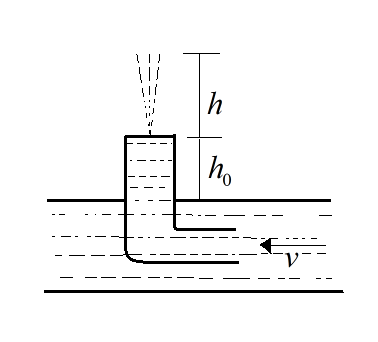
A bent tube is lowered into a water stream as shown in figure shown above. The velocity of the stream relative to the tube is equal to \[v=2.5m{{s}^{-1}}\]. The closed upper end of the tube located at the height \[{{h}_{0}}=12cm\] has a small orifice. The height h (in cm) the water jet spurt is \[2\times {{10}^{x}}\]. Find \[x\].


Answer
583.5k+ views
Hint: The water coming in the tube with a certain velocity, went out through orifice. It follows the energy conservation law. The kinetic energy due to velocity v is converted into potential energy, and this kinetic energy is used to raise the water to height h.
Complete step by step answer:
In hydrodynamics Bernoulli had derived the equation for energy conservation law; which states that energy is neither created nor destroyed. It changes from one form to another form.
By Bernoulli’s Theorem:
\[P+\rho gh+\dfrac{1}{2}\rho {{v}^{2}}=\]Constant
Where:
\[P=\]Atmospheric pressure
\[\rho =\]density of fluid
\[h=\] height above the surface
\[v=\]velocity of fluid
In our question atmospheric pressure inside the tube is zero.
Therefore we apply Bernoulli’s Theorem at the entering point (where water enters into the tube) and at the end point (or orifice) from where water ejects.
\[\begin{align}
& \dfrac{1}{2}\rho {{v}_{in}}^{2}=\dfrac{1}{2}\rho {{v}^{2}}_{out}+\rho g{{h}_{0}} \\
& {{v}^{2}}_{out}={{v}_{in}}^{2}-2g{{h}_{0}} \\
\end{align}\]
This is the velocity that comes out from orifice.
Now again applying energy conservation law, so that water can jump to height h.
Total Initial Energy = Total Final Energy
\[\begin{align}
& \dfrac{1}{2}m{{v}_{out}}^{2}=mgh \\
& {{v}^{2}}_{out}=gh \\
& {{v}_{in}}^{2}-2g{{h}_{0}}=gh \\
& h=\dfrac{{{v}_{in}}^{2}-2g{{h}_{0}}}{2g} \\
\end{align}\]
Putting the values of all parameters in the above equation, we get
\[\begin{align}
& h=\dfrac{{{2.5}^{2}}-2\times 9.8\times 12\times {{10}^{-2}}}{2\times 9.8} \\
& h=0.20m \\
& h=2\times 10cm \\
\end{align}\]
Comparing this height with the question height we can find the value of x
\[2\times 10=2\times {{10}^{x}}\]
\[\]
Hence, the height through which the water rises is 20cm. And by comparing the height of the above equation, we find that x must be equals to 1.
Note: Sometimes students forget to put the SI units, for example if height is given in cm first change it into meters then find the answer.
To find height or to find velocity we always use energy conservation law.
Complete step by step answer:
In hydrodynamics Bernoulli had derived the equation for energy conservation law; which states that energy is neither created nor destroyed. It changes from one form to another form.
By Bernoulli’s Theorem:
\[P+\rho gh+\dfrac{1}{2}\rho {{v}^{2}}=\]Constant
Where:
\[P=\]Atmospheric pressure
\[\rho =\]density of fluid
\[h=\] height above the surface
\[v=\]velocity of fluid
In our question atmospheric pressure inside the tube is zero.
Therefore we apply Bernoulli’s Theorem at the entering point (where water enters into the tube) and at the end point (or orifice) from where water ejects.
\[\begin{align}
& \dfrac{1}{2}\rho {{v}_{in}}^{2}=\dfrac{1}{2}\rho {{v}^{2}}_{out}+\rho g{{h}_{0}} \\
& {{v}^{2}}_{out}={{v}_{in}}^{2}-2g{{h}_{0}} \\
\end{align}\]
This is the velocity that comes out from orifice.
Now again applying energy conservation law, so that water can jump to height h.
Total Initial Energy = Total Final Energy
\[\begin{align}
& \dfrac{1}{2}m{{v}_{out}}^{2}=mgh \\
& {{v}^{2}}_{out}=gh \\
& {{v}_{in}}^{2}-2g{{h}_{0}}=gh \\
& h=\dfrac{{{v}_{in}}^{2}-2g{{h}_{0}}}{2g} \\
\end{align}\]
Putting the values of all parameters in the above equation, we get
\[\begin{align}
& h=\dfrac{{{2.5}^{2}}-2\times 9.8\times 12\times {{10}^{-2}}}{2\times 9.8} \\
& h=0.20m \\
& h=2\times 10cm \\
\end{align}\]
Comparing this height with the question height we can find the value of x
\[2\times 10=2\times {{10}^{x}}\]
\[\]
Hence, the height through which the water rises is 20cm. And by comparing the height of the above equation, we find that x must be equals to 1.
Note: Sometimes students forget to put the SI units, for example if height is given in cm first change it into meters then find the answer.
To find height or to find velocity we always use energy conservation law.
Recently Updated Pages
Master Class 11 Economics: Engaging Questions & Answers for Success

Master Class 11 English: Engaging Questions & Answers for Success

Master Class 11 Social Science: Engaging Questions & Answers for Success

Master Class 11 Biology: Engaging Questions & Answers for Success

Class 11 Question and Answer - Your Ultimate Solutions Guide

Master Class 11 Business Studies: Engaging Questions & Answers for Success

Trending doubts
10 examples of friction in our daily life

One Metric ton is equal to kg A 10000 B 1000 C 100 class 11 physics CBSE

Difference Between Prokaryotic Cells and Eukaryotic Cells

1 Quintal is equal to a 110 kg b 10 kg c 100kg d 1000 class 11 physics CBSE

State the laws of reflection of light

Explain zero factorial class 11 maths CBSE




